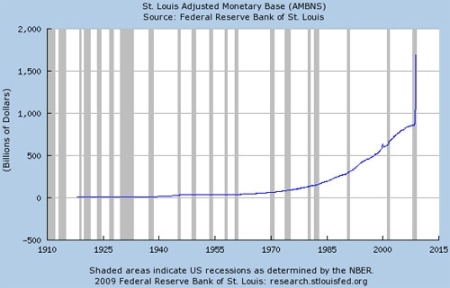David Freddoso has an insightful article on The Corner on National Review titled The Case for No Stimulus, which includes a thought-provoking interview with budget analyst Brian Riedl of the Heritage Foundation. This piece is worth careful study as it refutes several economic fallacies that have become fashionable once again in our brave new economic Dark Ages.
Riedl explains why Keynesian government spending efforts to end recession is not only ineffective in the short-run, but harmful in the long run:
NRO: In this stimulus debate, no one is answering or even discussing an important question: Where is the money coming from? Can you stimulate the economy by spending money that you must first remove from the economy by borrowing?
Riedl: That is a great question. The grand Keynesian myth is that you can spend money and thereby increase demand. And it’s a myth because Congress does not have a vault of money to distribute in the economy. Every dollar Congress injects into the economy must first be taxed or borrowed out of the economy. You’re not creating new demand, you’re just transferring it from one group of people to another. If Washington borrows the money from domestic lenders, then investment spending falls, dollar for dollar. If they borrow the money from foreigners, say from China, then net exports drop dollar for dollar, because the balance of payments must adjust. Therefore, again, there is no net increase in aggregate demand. It just means that one group of people has $800 billion less to spend, and the government has $800 billion more to spend.
A particularly egregious yet ubiquitous fallacy these days is the idea that increased consumer spending is good for the economy while saving and investment are bad. This idea is not simply wrong-headed, but mind-bogglingly so, yet if you turn on the evening news or read a newspaper, you’ll encounter myriad variations on this theme.
Riedl explains:
There is this notion that the redistribution of money from savers to spenders creates new spending. But that assumes that people store their savings in their mattresses. That may have been true in the 1930s, but today, people use their savings to pay down debts or invest. Or they put it into the bank, who in turn lends it to others to spend. Therefore, savings circulate through the investment side of the economy, which counts just as much in the GDP as the consumption side of the economy. So even the saving versus spending distinction doesn’t make any sense.
The simple fact is that the only way to create economic growth is to increase productivity. Redistributing money from one group of people to another doesn’t create productivity or economic growth.
The Keynesian myth persists in spite of numerous spectacular failures. I recently read that when President Obama met with Congressional Republicans, he privately acknowledged that the New Deal failed to end the Great Depression, but concluded that the reason it failed was because the New Deal programs cost too little.
Obama apparently believes, in spite of overwhelming empirical evidence to the contrary, that Keynesian prescriptions for government spending should work, so when they fail as they always have, he assumes that they failed because the government didn’t spend more. This is an example of magical thinking that one pundit described as “ideological addictions to economically counterproductive programs.” Is there a better definition of communism than this?
The price tag for the October surprise, er bank bailout was $700 billion. That’s a seven followed by 11 zeros in front of the decimal point, or $700,000,000,000.00 of debt on top of what we already owe. It didn’t work. The price tag on the so-called stimulus bill is in excess of $1 trillion. That’s a one followed by 12 zeros, or $1,000,000,000,000.00 of borrowing on top of our already massive national debt. If this stimulus plan doesn’t work, then what?
Obama and other true believers in failed Keynesian policies will never renounce their faith because their core beliefs are ultimately non-falsifiable. No matter how often or how spectacularly massive government spending plans fail, the True Believers will say it was because the government didn’t spend enough.
Common sense tells us otherwise. All of us know people who always seem to live beyond their means. Sometimes we wonder if these people have discovered some magical financial secret formula that the rest of us missed. They have found a trick all right, but only the cheap trick of using other people’s money to create the illusion of wealth. It only works as long as you can avoid paying the money back.
Riedl sums it up:
Keynesian economics offers the promise of a free lunch. It offers the idea that government can wave a magic wand, spend money, and make the recession end in a pain-free way. It’s just not that easy.




 Posted by Ed
Posted by Ed 

